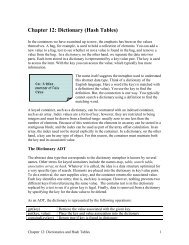Engineering Education and the Development of Expertise - Classes
Engineering Education and the Development of Expertise - Classes
Engineering Education and the Development of Expertise - Classes
Create successful ePaper yourself
Turn your PDF publications into a flip-book with our unique Google optimized e-Paper software.
100 (January 2011) 1 Journal <strong>of</strong> <strong>Engineering</strong> <strong>Education</strong><br />
A number <strong>of</strong> engineering programs around <strong>the</strong> world have made a commitment to <strong>the</strong><br />
integration <strong>of</strong> PBL across courses. The first such program to do this was Chemical<br />
<strong>Engineering</strong> at McMaster University in Canada with an effort that began in <strong>the</strong> late sixties<br />
(Woods et al., 1997). That work was followed by a few o<strong>the</strong>rs in <strong>the</strong> U.S. <strong>and</strong> Europe including<br />
Worcester Polytechnic Institute (Hazzard, 1975, Grogan, Schachterle, & Lutz,<br />
1988), Aalborg University, Linkoping, Roskilde, & Maastricht. More recently, a number<br />
<strong>of</strong> engineering programs in Australia have rebuilt <strong>the</strong>ir curricula around PBL including<br />
Civil <strong>Engineering</strong> at Monash (Hadgraft & Grundy, 1998) <strong>and</strong> at <strong>the</strong> University <strong>of</strong> Sou<strong>the</strong>rn<br />
Queensl<strong>and</strong> where traditional courses on computers, instrumentation, <strong>and</strong> numerical<br />
analysis were replaced with PBL courses (Brodie, 2007) as well as Chemical <strong>Engineering</strong><br />
at <strong>the</strong> University <strong>of</strong> Queensl<strong>and</strong>, Central Queensl<strong>and</strong> University (CQU), University <strong>of</strong><br />
South Australia, Victoria University (VU), <strong>and</strong> RMIT University (Hadgraft & Muir,<br />
2003). The approach to integrating PBL into <strong>the</strong> curriculum at Aalborg University is <strong>the</strong><br />
best documented in <strong>the</strong> literature (e.g, De Graaff & Kolmos, 2003; Kolmos, 1996) <strong>and</strong><br />
will serve as <strong>the</strong> primary example <strong>of</strong> <strong>the</strong> use <strong>of</strong> PBL at <strong>the</strong> course level.<br />
At Aalborg, student teams for PBL contain up to seven students; <strong>the</strong> number <strong>of</strong> students<br />
in <strong>the</strong> team gets smaller as <strong>the</strong> students progress through <strong>the</strong>ir studies. Every semester<br />
<strong>the</strong> teams produce a major project report, on <strong>the</strong> order <strong>of</strong> 70 pages in length. For <strong>the</strong>ir<br />
PBL project <strong>the</strong> teams have two supervisors. One serves as a technical expert in <strong>the</strong> broad<br />
domain <strong>of</strong> <strong>the</strong> project <strong>and</strong> serves as <strong>the</strong> main supervisor. The second supervisor supports<br />
underst<strong>and</strong>ing <strong>of</strong> <strong>the</strong> broader context <strong>of</strong> <strong>the</strong> problem <strong>and</strong> serves as <strong>the</strong> primary advisor during<br />
<strong>the</strong> writing phase <strong>of</strong> <strong>the</strong> project. In addition to <strong>the</strong> PBL experience, students typically<br />
are taking several courses. Some <strong>of</strong> <strong>the</strong> courses focus on building <strong>the</strong> skills required for<br />
PBL while o<strong>the</strong>r courses are intended to build knowledge in specific subjects such as ma<strong>the</strong>matics,<br />
science, or engineering.<br />
In some cases students are given a choice <strong>of</strong> projects. For example, first-year students<br />
can choose among projects related to ma<strong>the</strong>matics such as: bird flu, how to measure spread<br />
scenarios, DNA-micro array techniques in support <strong>of</strong> diagnosing diseases, <strong>and</strong> Google’s<br />
page rank system (Christensen, 2008). Each project is summarized in a one-page description.<br />
Once a team chooses a project, <strong>the</strong>y begin defining <strong>the</strong>ir strategy for addressing <strong>the</strong><br />
project <strong>and</strong> preparing <strong>the</strong> final report, in close collaboration with <strong>the</strong> two supervisors.<br />
Christensen describes each <strong>of</strong> <strong>the</strong>se problems <strong>and</strong> how <strong>the</strong> students approached <strong>the</strong>m. For<br />
example, in <strong>the</strong> bird flu project, <strong>the</strong> team <strong>of</strong> seven students decided to address <strong>the</strong> issue <strong>of</strong> how<br />
many people would become ill <strong>and</strong> die if <strong>the</strong> disease reached Denmark. To answer this question,<br />
<strong>the</strong> students had to engage not only ma<strong>the</strong>matical knowledge but <strong>the</strong>y also had to find<br />
answers to questions like “How does <strong>the</strong> bird flu spread?” <strong>and</strong> “How effective is Tamiflu® in<br />
preventing it?” The students actually reframed <strong>the</strong> question that <strong>the</strong>y wished to address <strong>and</strong> focused<br />
on <strong>the</strong> possible overreaction <strong>of</strong> <strong>the</strong> public to <strong>the</strong> threat <strong>of</strong> bird flu. They used <strong>the</strong>ir ma<strong>the</strong>matical<br />
models <strong>and</strong> a range <strong>of</strong> assumptions to formulate “realistic” <strong>and</strong> “worst case” scenarios.<br />
Thus, this problem statement led <strong>the</strong> students to learn a good deal about <strong>the</strong> spread <strong>of</strong> disease<br />
<strong>and</strong> consequences <strong>of</strong> predictions made using <strong>the</strong>ir ma<strong>the</strong>matical tools.<br />
Employer evaluations comparing Aalborg graduates to students from <strong>the</strong> Technical<br />
University <strong>of</strong> Denmark (DTU), which does not make extensive use <strong>of</strong> PBL, show clear superiority<br />
on a number <strong>of</strong> criteria (Kjærsdam, 2004). Forty-one percent <strong>of</strong> respondents evaluated<br />
Aalborg graduates as good or very good at project <strong>and</strong> people management versus<br />
just 9% for DTU. Aalborg graduates were also rated higher in innovative/creative skills<br />
(81%/59%). Graduates <strong>of</strong> <strong>the</strong> two programs received equivalent ratings on quality <strong>of</strong><br />
engineering <strong>and</strong> technical skills (86%/85%). Thus <strong>the</strong> intensive focus on PBL seems to<br />
135
















